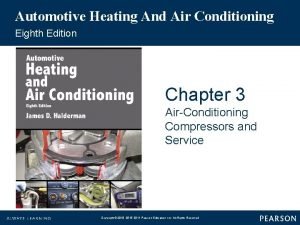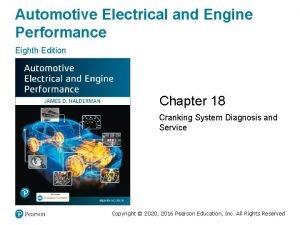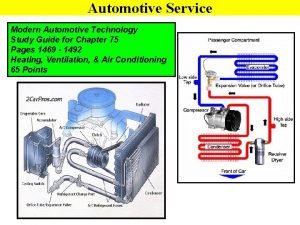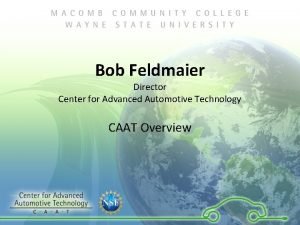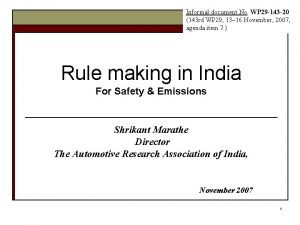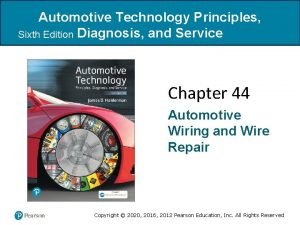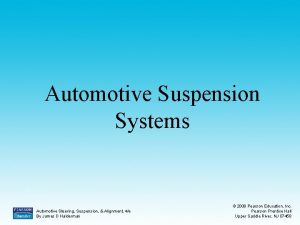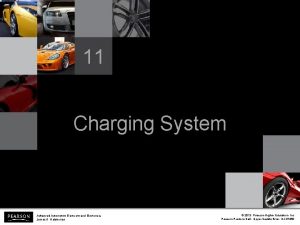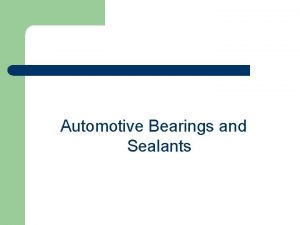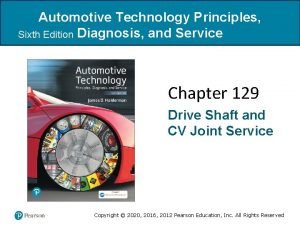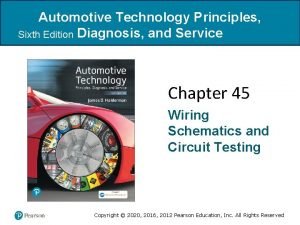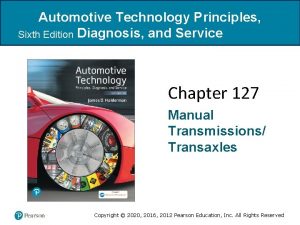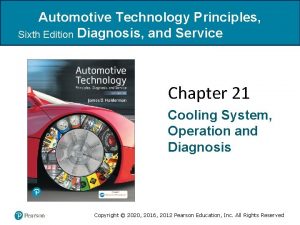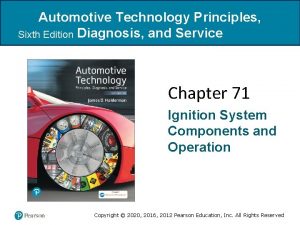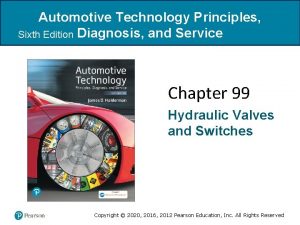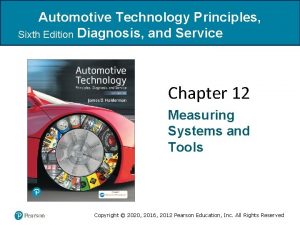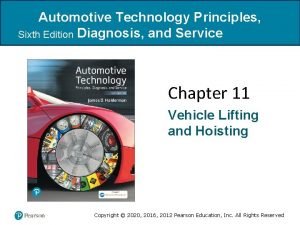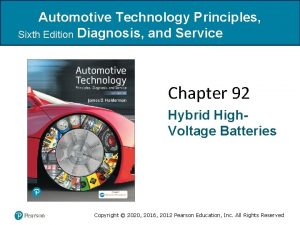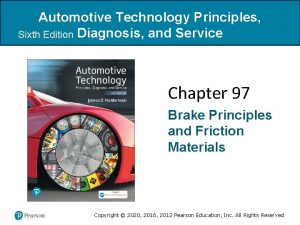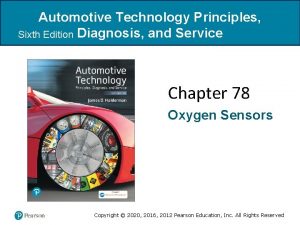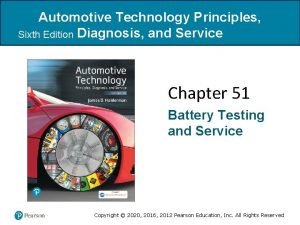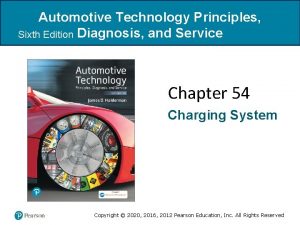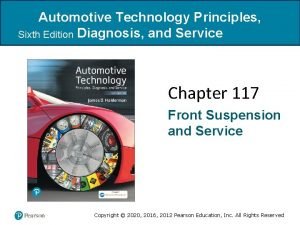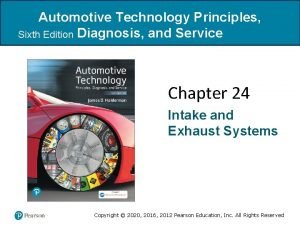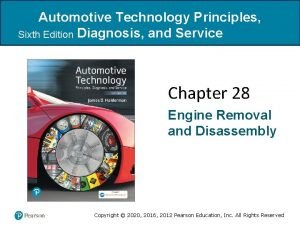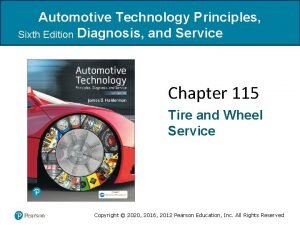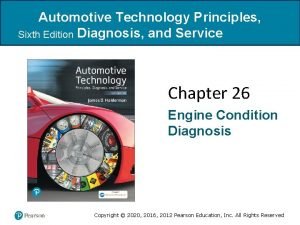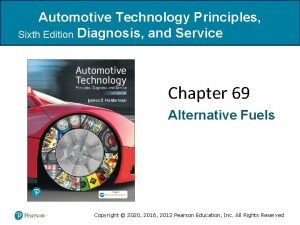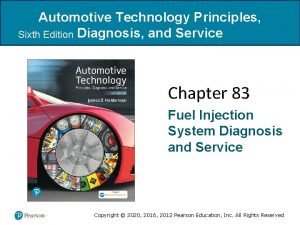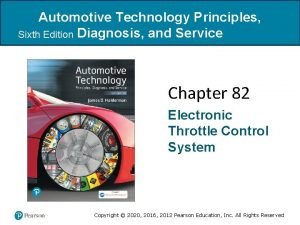Automotive Technology Principles Sixth Edition Diagnosis and Service




























































- Slides: 60

Automotive Technology Principles, Sixth Edition Diagnosis, and Service Chapter 94 Hybrid Safety and Service Procedures Copyright © 2018, 2015, 2011 Pearson Education, Inc. All Rights Reserved Copyright © 2020, 2016, 2012 Pearson Education, Inc. All Rights Reserved

LEARNING OBJECTIVES (1 of 2) 94. 1 Correctly use appropriate personal protective equipment (PPE). 94. 2 Discuss the safety interlock system and loss of insulation in a hybrid electric vehicle. 94. 3 Safely de-power a hybrid electric vehicle. Copyright © 2020, 2016, 2012 Pearson Education, Inc. All Rights Reserved

LEARNING OBJECTIVES (2 of 2) 94. 4 Explain hazards while driving, moving, and hoisting a hybrid electric vehicle. 94. 5 Perform routine vehicle service procedure on a hybrid electric vehicle and understand the HEV's unique service requirements. Copyright © 2020, 2016, 2012 Pearson Education, Inc. All Rights Reserved

HIGH-VOLTAGE SAFETY • Need For Caution – Hybrid electric vehicles and all electric vehicles use high-voltage (HV) circuits that, if touched with an unprotected hand, could cause serious burns, or even death. • Identifying High-Voltage Circuits – Blue or yellow. 42 volts (not a shock hazard but an arc is maintained if a circuit is opened) – Orange. 60 to 600 volts or higher Copyright © 2020, 2016, 2012 Pearson Education, Inc. All Rights Reserved

HIGH VOLTAGE-SAFETY EQUIPMENT (1 OF 2) • Rubber Gloves – Be sure that the gloves are rated for at least 1, 000 volts and class “ 0” by ANSI/ASTM. – Before using the rubber gloves, they should be tested for leaks. • CAT-III Rated Multimeter – A CAT III-certified digital multimeter (DMM) is required for making measurements on these high-voltage systems. Copyright © 2020, 2016, 2012 Pearson Education, Inc. All Rights Reserved

HIGH VOLTAGE-SAFETY EQUIPMENT (2 OF 2) • Eye Protection – Eye protection should be worn when testing for HV, which is considered by many experts to be over 60 volts. • Safety Cones – Ford requires that cones be placed at the four corners of any hybrid electric vehicle when service work on the HV system is being performed. • Fiberglass Pole – A ten-foot insulated pole used to rescue a shock victim. Copyright © 2020, 2016, 2012 Pearson Education, Inc. All Rights Reserved

Figure 94. 1 Appropriate personal protective equipment (PPE) must be worn whenever working on or around a hybrid vehicle highvoltage system, including high-voltage gloves with protective leather gloves to protect the rubber from being cut or pierced Copyright © 2020, 2016, 2012 Pearson Education, Inc. All Rights Reserved

Figure 94. 2 Whenever working around the high-voltage circuit, it is recommended that one hand be kept in a pocket to prevent the possibility of a high-voltage shock passing through the body Copyright © 2020, 2016, 2012 Pearson Education, Inc. All Rights Reserved

Figure 94. 3 Checking rubber lineman’s gloves for pinhole leaks Copyright © 2020, 2016, 2012 Pearson Education, Inc. All Rights Reserved

QUESTION 1: ? What should be the rating of the rubber gloves? Copyright © 2020, 2016, 2012 Pearson Education, Inc. All Rights Reserved

ANSWER 1: Class “ 0” and 1000 Volts. Copyright © 2020, 2016, 2012 Pearson Education, Inc. All Rights Reserved

FREQUENTLY ASKED QUESTION Copyright © 2020, 2016, 2012 Pearson Education, Inc. All Rights Reserved

Figure 94. 4 Be sure to only use a meter that is CAT IIIrated when taking electrical voltage measurements on a hybrid electric or electric vehicle. Copyright © 2020, 2016, 2012 Pearson Education, Inc. All Rights Reserved

Figure 94. 5 The meter leads should also be CAT III-rated when checking voltages on a hybrid electric vehicle Copyright © 2020, 2016, 2012 Pearson Education, Inc. All Rights Reserved

SAFETY INTERLOCK SYSTEM • Purpose and Function – This is a safety system that keeps the power relays from closing. – With an open detected, the hybrid controller set fault codes and shutdown the ICE in an orderly manner to keep the vehicle safe. • Local Interlock – Separate switches on high voltage components and circuits used to detect open circuits. Copyright © 2020, 2016, 2012 Pearson Education, Inc. All Rights Reserved

Figure 94. 6 The HV disconnect plug has two small terminals used to signal the HV controller that the safety/service plug has been removed. Copyright © 2020, 2016, 2012 Pearson Education, Inc. All Rights Reserved

LOSS OF ISOLATION TEST • Purpose – The HV circuits do not use a common ground. – When the ground fault system detects HV leaking to ground, it sets a DTC that includes the location of the fault. • Test Procedure – Disable the HV system – Use DTCs and schematics to identify problem areas – Connect the isolation tester to the circuit, perform the test and record the results. Copyright © 2020, 2016, 2012 Pearson Education, Inc. All Rights Reserved

Figure 94. 7 An insulation tester showing where the meter leads should be attached and where to select the voltage level to be used to test the insulation (usually 1, 000 volts). The resistance between the insulated HV circuit and ground should be higher than one million ohms (1. 0 to 2. 2 MΩ) Copyright © 2020, 2016, 2012 Pearson Education, Inc. All Rights Reserved

QUESTION 2: ? What is the purpose of the Loss of Isolation Test? Copyright © 2020, 2016, 2012 Pearson Education, Inc. All Rights Reserved

ANSWER 2: The cylinder head did not contain the valves. Copyright © 2020, 2016, 2012 Pearson Education, Inc. All Rights Reserved

ELECTRIC SHOCK POTENTIAL • Locations Where Shock Can Occur – – Contact with the battery module Contact with the electric motor The HV cables The system main relays (SMRs) Copyright © 2020, 2016, 2012 Pearson Education, Inc. All Rights Reserved

TECH TIP Copyright © 2020, 2016, 2012 Pearson Education, Inc. All Rights Reserved

Figure 94. 8 The Ford Escape Hybrid instrument panel showing the vehicle in park and the tachometer on “EV” instead of 0 RPM. This means that the gasoline engine could start at any time, depending on the state of charge of the high-voltage batteries and other factors Copyright © 2020, 2016, 2012 Pearson Education, Inc. All Rights Reserved

FREQUENTLY ASKED QUESTION Copyright © 2020, 2016, 2012 Pearson Education, Inc. All Rights Reserved

Figure 94. 9 To enter the inspection mode, select this feature on a scan tool and follow the on-screen procedure Copyright © 2020, 2016, 2012 Pearson Education, Inc. All Rights Reserved

DE-POWERING THE HIGH-VOLTAGE SYSTEM • The Need to De-power the High-Voltage System – Work is going to be performed on any of the following components: – The high-voltage (HV) battery pack – Any of the electronic controllers that use orange cables, such as the inverter and converters – The air-conditioning compressor if electrically driven and has orange cables attached. • To safely de-power the vehicle, always follow the instructions found in service information for the exact vehicle being serviced. Copyright © 2020, 2016, 2012 Pearson Education, Inc. All Rights Reserved

COLLISION AND REPAIR INDUSTRY ISSUES • Jump Starting – The 12 -volt auxiliary battery may be jump started if the vehicle does not start. – The high voltage battery cannot be jump started on most vehicles. Copyright © 2020, 2016, 2012 Pearson Education, Inc. All Rights Reserved

Figure 94. 10 Jump starting a 2001– 2003 Toyota Prius using a 12 -volt supply to boost the 12 -volt auxiliary battery in the trunk Copyright © 2020, 2016, 2012 Pearson Education, Inc. All Rights Reserved

Figure 94. 11 The underhood 12 -volt jump-start terminal on this 2014 Toyota Prius has a red plastic cover with a “+” sign. The positive booster cable clamp attaches directly to the vertical metal bracket. Copyright © 2020, 2016, 2012 Pearson Education, Inc. All Rights Reserved

MOVING AND TOWING A HYBRID • Towing – To transport a vehicle a flat-bed truck should be used. • Moving the Hybrid Vehicle in the Shop – Make sure to tape any orange cable ends that were disconnected during the repair procedure. – It is possible that a high-voltage arc could occur as the wheels turn and produce voltage. Copyright © 2020, 2016, 2012 Pearson Education, Inc. All Rights Reserved

Figure 94. 12 Using a warning cover the steering wheel helps others realize that work is being performed on the highvoltage system and that no one is to attempt to start or move the vehicle. Copyright © 2020, 2016, 2012 Pearson Education, Inc. All Rights Reserved

Figure 94. 13 A lock box is a safe location to keep the ignition keys of a hybrid electric vehicle while it is being serviced. Copyright © 2020, 2016, 2012 Pearson Education, Inc. All Rights Reserved

REMOVING THE HIGH-VOLTAGE BATTERY • Precautions – The HV battery box should always be removed as an assembly, placed on a rubber-covered work bench. • Storing the High-Voltage Battery – If a hybrid is to be stored for any length of time, the state of charge of the HV must be maintained. • Hoisting a Hybrid Vehicle – When hoisting or using a floor jack, pay attention to the lift points. Orange cables run under the vehicle just inside the frame rails on most hybrids. Copyright © 2020, 2016, 2012 Pearson Education, Inc. All Rights Reserved

Figure 94. 14 Insulated tools, such as this socket set, provide an additional margin of safety to the service technician when working around high-voltage components and systems. Copyright © 2020, 2016, 2012 Pearson Education, Inc. All Rights Reserved

Figure 94. 15 The high-voltage wiring on this Honda hybrid is colored orange for easy identification Copyright © 2020, 2016, 2012 Pearson Education, Inc. All Rights Reserved

QUESTION 3: ? What precautions should be taken when lifting a HEV? Copyright © 2020, 2016, 2012 Pearson Education, Inc. All Rights Reserved

ANSWER 3: Lift the vehicle in the proper location and note the location of the orange HV cables. Copyright © 2020, 2016, 2012 Pearson Education, Inc. All Rights Reserved

ROUTINE SERVICE PROCEDURES (1 OF 4) • Diagnostic Procedure – – – Verify the customer concern. Check for diagnostic trouble codes (DTCs). Perform a thorough visual inspection. Check for technical service bulletins (TSBs) Follow service information specified steps and procedures. – Determine and repair the root cause of the problem. – Verify the repair Copyright © 2020, 2016, 2012 Pearson Education, Inc. All Rights Reserved

ROUTINE SERVICE PROCEDURES (2 OF 4) • Oil Change – An oil change is similar to changing oil in any vehicle equipped with an internal combustion engine. • Cooling System Service – Multiple cooling systems are serviced using the specific coolant mixture at the correct mileage interval. • Air Filter Service – Similar to performing this service in any vehicle equipped with an internal combustion engine. Copyright © 2020, 2016, 2012 Pearson Education, Inc. All Rights Reserved

ROUTINE SERVICE PROCEDURES (3 OF 4) • Air-Conditioning Service – Many HEVs use an air-conditioning compressor that uses high voltage from the HV battery pack – Special refrigerant oil is used that is nonconductive. • Steering System Service – Most HEVs use an electric power steering system that operates at 12 or 42 volts. • Braking System Service – More frequent cleaning and lubrication due to regenerative braking. Copyright © 2020, 2016, 2012 Pearson Education, Inc. All Rights Reserved

ROUTINE SERVICE PROCEDURES (4 OF 4) • Tires – Many HEVs have special “green” tires. Refer to the service information for correct replacement tires. • Auxiliary Battery Testing and Service – Auxiliary batteries may be the flooded type or absorbed glass mat type. Refer to the service information for the correct service procedure. Copyright © 2020, 2016, 2012 Pearson Education, Inc. All Rights Reserved

Figure 94. 16 A scan tool display showing two hybridrelated faults in this Ford Escape hybrid Copyright © 2020, 2016, 2012 Pearson Education, Inc. All Rights Reserved

Figure 94. 17 Always use the specified viscosity of oil in a hybrid electric vehicle, not only for best fuel economy, but also because of the need for fast lubrication because of the engine (idle) stop feature Copyright © 2020, 2016, 2012 Pearson Education, Inc. All Rights Reserved

FREQUENTLY ASKED QUESTION Copyright © 2020, 2016, 2012 Pearson Education, Inc. All Rights Reserved

Figure 94. 18 The radiation emitted from a hybrid electric vehicle is very low, as shown being measured in units of milligauss Copyright © 2020, 2016, 2012 Pearson Education, Inc. All Rights Reserved

Figure 94. 19 This 12 -volt battery under the hood on a Ford Fusion hybrid is a flooded-cell-type auxiliary battery Copyright © 2020, 2016, 2012 Pearson Education, Inc. All Rights Reserved

HV GLOVE USE Copyright © 2020, 2016, 2012 Pearson Education, Inc. All Rights Reserved

1. The cuff of the rubber glove should extend at least ½ inch beyond the cuff of the leather protector. Copyright © 2020, 2016, 2012 Pearson Education, Inc. All Rights Reserved

2. To determine correct glove size, use a soft tape to measure around the palm of the hand. A measurement of 9 inches corresponds with a glove size of 9. Copyright © 2020, 2016, 2012 Pearson Education, Inc. All Rights Reserved

3. The glove rating and the date of the last test should be stamped on the glove cuff. Copyright © 2020, 2016, 2012 Pearson Education, Inc. All Rights Reserved

4. Start with a visual inspection of the glove fingertips, making sure that no cuts or other damage is present. Copyright © 2020, 2016, 2012 Pearson Education, Inc. All Rights Reserved

5. The damage on this glove was easily detected with a simple visual inspection. Note that the rubber glove material can be damaged by petroleum products, detergents, certain hand soaps, and talcum powder. Copyright © 2020, 2016, 2012 Pearson Education, Inc. All Rights Reserved

6. Manually inflate the glove to inspect for pinhole leaks. Starting at the cuff, roll up the glove and trap air at the finger end. Listen and watch carefully for deflation of the glove. If a leak is detected, the glove must be discarded. Copyright © 2020, 2016, 2012 Pearson Education, Inc. All Rights Reserved

7. Petroleum on the leather protector’s surfaces damages the rubber glove underneath. Copyright © 2020, 2016, 2012 Pearson Education, Inc. All Rights Reserved

8. Glove powder (glove dust) should be used to absorb moisture and reduce friction. Copyright © 2020, 2016, 2012 Pearson Education, Inc. All Rights Reserved

9. Put on the gloves and tighten the straps on the back of the leather protectors. Copyright © 2020, 2016, 2012 Pearson Education, Inc. All Rights Reserved

10. Technicians MUST wear HV gloves and leather protectors whenever working around the high-voltage areas of a hybrid electric vehicle. Copyright © 2020, 2016, 2012 Pearson Education, Inc. All Rights Reserved

11. HV gloves and leather protectors should be placed in a canvas storage bag when not in use. Note the ventilation hole at the bottom of this bag. Copyright © 2020, 2016, 2012 Pearson Education, Inc. All Rights Reserved

12. Make sure that the rubber gloves are not folded when placed in the canvas bag. Folding increases mechanical stress on the rubber and can lead to premature failure of the glove material. Copyright © 2020, 2016, 2012 Pearson Education, Inc. All Rights Reserved

Copyright © 2020, 2016, 2012 Pearson Education, Inc. All Rights Reserved
 Automotive technology sixth edition
Automotive technology sixth edition Automotive technology sixth edition
Automotive technology sixth edition Rational people think at the margin
Rational people think at the margin Mmodation
Mmodation Rubber baby buggy bumpers tongue twister lyrics
Rubber baby buggy bumpers tongue twister lyrics Automotive heating and air conditioning 8th edition
Automotive heating and air conditioning 8th edition Biochemistry sixth edition 2007 w.h. freeman and company
Biochemistry sixth edition 2007 w.h. freeman and company Automotive engines 8th edition
Automotive engines 8th edition China automotive technology and research center
China automotive technology and research center Computer architecture a quantitative approach sixth edition
Computer architecture a quantitative approach sixth edition Citation sample pdf
Citation sample pdf Computer architecture a quantitative approach 6th
Computer architecture a quantitative approach 6th Precalculus sixth edition
Precalculus sixth edition Computer architecture a quantitative approach sixth edition
Computer architecture a quantitative approach sixth edition Nursing process assessment
Nursing process assessment Medical diagnosis and nursing diagnosis difference
Medical diagnosis and nursing diagnosis difference Second phase of nursing process
Second phase of nursing process Medical diagnosis and nursing diagnosis difference
Medical diagnosis and nursing diagnosis difference Modern automotive technology answer key
Modern automotive technology answer key Control system
Control system Structural mechanics exam questions
Structural mechanics exam questions Autocaat
Autocaat Rivet split pin
Rivet split pin Sixth sense technology seminar report
Sixth sense technology seminar report Sixth sense technology seminar
Sixth sense technology seminar Sixth sense technology documentation
Sixth sense technology documentation Perbedaan diagnosis gizi dan diagnosis medis
Perbedaan diagnosis gizi dan diagnosis medis Power brake system
Power brake system Using mis 10th edition
Using mis 10th edition Using mis 10th edition
Using mis 10th edition Computer security principles and practice
Computer security principles and practice Computer security principles and practice 4th edition
Computer security principles and practice 4th edition Expert systems: principles and programming, fourth edition
Expert systems: principles and programming, fourth edition Food and beverage service' 9 th edition
Food and beverage service' 9 th edition Food and beverage service' 9 th edition
Food and beverage service' 9 th edition Food service cycle
Food service cycle Food and beverage service' 9 th edition
Food and beverage service' 9 th edition Food and beverage service sequence
Food and beverage service sequence Qqq tea
Qqq tea Information technology project management 9th edition
Information technology project management 9th edition Information technology project management 9th edition ppt
Information technology project management 9th edition ppt Ethics in information technology fourth edition
Ethics in information technology fourth edition Ethics in information technology fourth edition
Ethics in information technology fourth edition Project management quality control
Project management quality control Project management chapter 6
Project management chapter 6 Basic environmental technology 6th edition pdf
Basic environmental technology 6th edition pdf Information technology project management 9th edition
Information technology project management 9th edition Automotive regulations and standards
Automotive regulations and standards Chapter 44 automotive wiring and wire repair
Chapter 44 automotive wiring and wire repair Automotive steering, suspension and alignment
Automotive steering, suspension and alignment Advanced automotive electronics
Advanced automotive electronics Chapter 2 automotive careers and ase certification
Chapter 2 automotive careers and ase certification Automotive maintenance and light repair answer key
Automotive maintenance and light repair answer key Fasteners gaskets seals and sealants
Fasteners gaskets seals and sealants Fasteners gaskets seals and sealants
Fasteners gaskets seals and sealants Automotive bearings and seals
Automotive bearings and seals Failure of supporting utilities and structural collapse
Failure of supporting utilities and structural collapse Principles of electronic communication systems 3rd edition
Principles of electronic communication systems 3rd edition Principles of economics third edition oxford pdf
Principles of economics third edition oxford pdf Accounting principles second canadian edition
Accounting principles second canadian edition Accounting principles second canadian edition
Accounting principles second canadian edition





